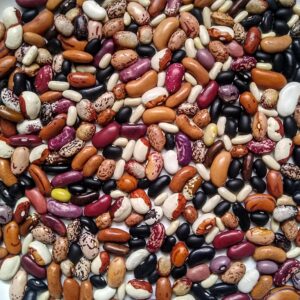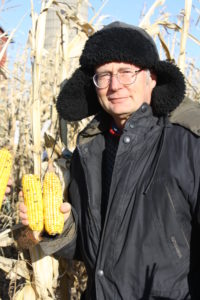
 The organic movement has grown because many recognize that the path of breeding and farming that humanity is presently engaged in needs to change if it is to lead to healthier humans and a healthier planet. In conception and practice, the agricultural research community has progressively disregarded the whole organism and its integrity in favor of industrial production goals and measures that grow out of molecular or one-sided thinking. The consequences appear to be associated with greater production but a progressive degeneration of health, taste, and nutritional density.
The organic movement has grown because many recognize that the path of breeding and farming that humanity is presently engaged in needs to change if it is to lead to healthier humans and a healthier planet. In conception and practice, the agricultural research community has progressively disregarded the whole organism and its integrity in favor of industrial production goals and measures that grow out of molecular or one-sided thinking. The consequences appear to be associated with greater production but a progressive degeneration of health, taste, and nutritional density.
There is a growing realization that if organic farming is to succeed long-term it will be necessary to breed healthy, productive, nutritious crops and breeds of animals that are suited to the environments found on organic farms. Such crops and animals also need to be capable of being productive under the stresses imposed by global climatic change.
Organic farming is a holistic approach that includes concepts of balance, productivity, quality, and integrity. Appropriate breeding objectives for an “organic” agriculture might include: 1) breeding crops that are uniquely adapted to organic, low-input conditions; 2) selecting them for enhanced health, vegetative vigor, taste, and nutritional value combined with productivity; and 3) practicing and teaching a qualitative-quantitative approach to breeding and management that includes organic values and involves and encourages others to practice this approach. The end result should be that unique seeds, that combine productivity and nutritional quality and are adapted to organic farming, become available for farmers and gardeners, and thereby enhance nutrition and the environment.
Creating a paradigm shift in approach
When it comes to results, attitude is, if not everything, a lot. The crops and animals that are being bred today, and the way we farm, are a reflection of our values and ideas just as much as the cultivars, races, and ways of farming in the past were a reflection of the values of other cultures. We have a lot to learn from those older cultures. Modern, one-sided emphases in breeding and production inputs have increased yields but led to progressive decreases in nutritional value of our crops and quality of our soils. The consequences of our breeding approach include greater problems with toxicity of gluten in wheat and fungal (Fusarium) toxins in corn.[1][2] In animal breeds we have over-bred animals for productivity with greater loss of instinct and greater health problems. Due to our breeding and production approaches, our cultivars have become dependent on fertilizers and pesticides, and our breeds have become dependent on greater use of anthelmithics and antibiotics, among other things.
Holistic approach vs. mechanistic
Concepts of balance and organism integrity are missing in modern breeding programs. The work of developing crops, breeds, and soils has been distorted by a prevalent, mechanistic-reductionist perspective. In breeding, this perspective ignores the existence of species as integrated wholes with a specific identity and integrity. According to the reductionist perspective on breeding crops and animals, whole organism performance is interesting and relevant only inasmuch as it is in line with expected outcomes based on the composition of the genes. This genetic agenda is actually outmoded as new understandings of epigenetic regulation indicate that higher level functions of the organism are “playing on the instrument” of the genes to achieve an integrated whole and that the genes are not necessarily “playing the plant.” Farmers and gardeners are constantly reminded by the crops and animals they work with that these organisms are entities with specific identities and needs that behave according to their own characteristic patterns. However, the presence of a higher level of organization or integration, no matter how clearly it may appear to practitioners or developmental biologists, is either rejected or has not yet been grasped by scientists, breeders, or seed companies who are rooted in the molecular-mechanistic perspective. But irrespective of our attitudes, for a cultivar to be exciting to producers it has to produce an exceptionally “fit” body that achieves a high degree of integration of functions and responses. The best way to measure this is by field performance.
In the past century crops and breeds were mostly bred in a qualitative-quantitative way. This approach exercised human judgment combined with measured performance of the organism as a whole. The qualitative-quantitative style of breeding could lead defacto over time to a systematic training of the human capacity to work with the crop or animal species as whole organisms, to learn from them by learning patterns of form, response or behavior, and to judge them correctly as whole organisms in conjunction with quantitative performance data.
In recent decades this approach has been progressively replaced by a purely quantitative-molecular perspective. It is now commonly believed that breeding should be laboratory-driven rather that field-driven, even though the bulk of proof still shows that field-driven breeding is still producing the large improvements associated with increasing grain yield in corn. Undoubtedly, recent development in genetic markers and gene sequencing are remarkable, scientifically interesting, and in some cases useful. They have a role to play in breeding, including for organic farming. However, the glamour of these new tools has apparently put us in danger of adopting an exclusively molecular perspective, reducing funding for breeding fit and competitive new crops and animals. Furthermore, the element of skilled human judgment has been de-emphasized at large breeding companies as programs become highly mechanized and increasingly remove the breeder from the nursery.
A vision for organic breeding
My vision for organic breeding involves human values, not just profits. Inherent in the organic approach is the belief in responsible stewardship. It is important for humanity to take better care of the organisms upon which we depend for our sustenance. These cultivars and breeds are our companions on Earth. We need a respectful, long-term strategy for their evolution on the earth. Such a perspective should develop effective qualitative-quantitative assessment of balance in order to maintain whole organism integrity while fully developing the inherent gifts of yield and quality in each species. This new approach implies a new attitude and learning process by human beings. It entails becoming more familiar with individual species, and taking them and their evolution on in a responsible way. It also entails sufficient and efficient observation work that allows breeders to develop their capacity for skilled judgment and selection of plants.
Respectful language
Organic breeders might also consider whether an organic approach should also entail changes in attitude and language. What do we mean when we refer to our cultivars as germplasm or plant materials? These words have become engrained by our schooling, but are they not reductionist concepts that color how we even conceive our work? Speaking of a seed stock as being “germplasm” conveys to me painful images of a nucleus quivering in a sea of protoplasm. Isn’t this diving down into the cellular level when we refer to a whole organism? Also the language of “plant material” degrades a living creature down to form of dead matter. We are unfairly reducing (degrading) these organisms. If being observant and capable of “internalizing” and learning from the target organism is an issue, then breeder attitude matters.
Walter Goldstein grew up and received his education in Washington state but now lives in Wisconsin. He has bred corn under organic conditions since 1989. He was Research Director of Michael Fields Agricultural Institute for 25 years before starting his own research and education organization called the Mandaamin Institute. Mandaamin is the Algonquian word for corn/the spirit of corn. It means “wonder seed.” The institute works to breed nutritionally valuable crops and promote health farming practices. Learn more about the institute here.
[i] There is increasing evidence that the runaway epidemic in wheat intolerance and celiac disease in the human population is associated with hard gluten in wheat. Decades of selection have resulted in new, superior wheat varieties with high contents of elastic, hard gluten. This gluten is associated with an enhanced ability of the dough to hold gas bubbles and to rise. The more of this elastic substance in wheat, the larger the loaf. Light, fluffy bread is of commercial value. Modern breeding of wheat for bread increased the gluten components (toxic peptide epitopes) that induce celiac disease. This gluten irritates the gut and engenders autoimmune responses that can have long-lasting negative consequences on the lives of ordinary people. (van den Broeck, H.C. de Jong, E. M. J. Salentijn, L. Dekking, D. Bosch, R. J. Hamer, L. J. W. J. Gilissen, I. M. van der Meer, M. J. M. Smulders. 2010. Presence of celiac disease epitopes in modern and old hexaploid wheat varieties: wheat breeding may have contributed to increased prevalence of celiac disease. Theor Appl Genet (2010) 121:1527–1539)
[ii] Modern cultivars in the US have been bred to have high levels of naturally toxic compounds called benzoxazinoids to biologically control first generation European Corn Borers and Corn Root Worm. Fungal Fusarium species thrive as endophytes in the presence of benzoxazinoids, as they can tolerate and break them down. The presence of these compounds results in profound reductions in diversity of endophytic communities and up to 35 times higher levels of Fusarium in tops and roots. (Saunders, M. and L.M. Kohn 2009. Evidence for alteration of fungal endophyte community assembly by host defense compounds New Phytologist (2009) 182: 229–238)
